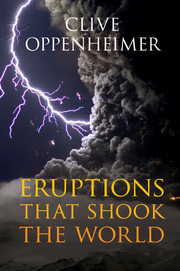Book contents
- Frontmatter
- Contents
- Preface
- Acknowledgements
- 1 Fire and brimstone: how volcanoes work
- 2 Eruption styles, hazards and ecosystem impacts
- 3 Volcanoes and global climate change
- 4 Forensic volcanology
- 5 Relics, myths and chronicles
- 6 Killer plumes
- 7 Human origins
- 8 The ash giant/sulphur dwarf
- 9 European volcanism in prehistory
- 10 The rise of Teotihuacán
- 11 Dark Ages: dark nature?
- 12 The haze famine
- 13 The last great subsistence crisis in the Western world
- 14 Volcanic catastrophe risk
- Appendix A Large eruptions
- Appendix B Further reading and data sources
- References
- Index
14 - Volcanic catastrophe risk
Published online by Cambridge University Press: 01 June 2011
- Frontmatter
- Contents
- Preface
- Acknowledgements
- 1 Fire and brimstone: how volcanoes work
- 2 Eruption styles, hazards and ecosystem impacts
- 3 Volcanoes and global climate change
- 4 Forensic volcanology
- 5 Relics, myths and chronicles
- 6 Killer plumes
- 7 Human origins
- 8 The ash giant/sulphur dwarf
- 9 European volcanism in prehistory
- 10 The rise of Teotihuacán
- 11 Dark Ages: dark nature?
- 12 The haze famine
- 13 The last great subsistence crisis in the Western world
- 14 Volcanic catastrophe risk
- Appendix A Large eruptions
- Appendix B Further reading and data sources
- References
- Index
Summary
One can make two diametrically opposed kinds of assertion: global risks inspire paralyzing terror, or: global risks create new room for action.
U. Beck, World Risk Society (2009) [259]… the diversity of individuals and institutions that draw on reservoirs of practices, knowledge, values, and worldviews … is crucial for preparing … for change, building resilience, and for coping with surprises.
W. N. Adger et al., Science (2005) [260]Each earthquake, flood and famine disaster tragically re-confirms how limited are the achievements that humankind has made in reducing catastrophic losses of life, especially in poorer countries. While actuaries do succeed in turning uncertainty into profit, their industry is rendered impotent in the face of the most severe global risks.Nevertheless, our exploration of some of the most significant volcanic eruptions, and the evidence for human resilience in terms of both the anticipation and reality of disaster, provide important lessons for understanding and managing volcanic risk in the future. It would be extremely difficult, for instance, to envision the impacts of a future super-eruption without knowledge of the pyroclastic deposits of Yellowstone, Toba or Taupo. Meanwhile, both archaeology and history offer rich insights into human ecology in the context of volcanic threat and impact. In this chapter, we draw these themes together to consider:
What are the worst-case eruption scenarios for the future?
How likely are they to happen?
Are they really as apocalyptic as some would have us believe?
Should we be concerned enough to take action to mitigate their adverse consequences and, if so, what kind of action?
- Type
- Chapter
- Information
- Eruptions that Shook the World , pp. 320 - 354Publisher: Cambridge University PressPrint publication year: 2011



